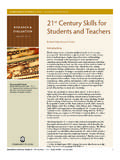Transcription of Preparing a health care workforce for the 21st century
1 World health OrganizationNoncommunicable Diseases and Mental health ClusterChronic Diseases and health Promotion DepartmentPreparing a health care workforce for the 21st centuryTHE CHALLENGE OF CHRONIC CONDITIONSWHO Library Cataloguing-in-Publication DataPreparing a health care workforce for the 21st century : the challenge of chronic health personnel education 2. health personnel trends 2. Professional competence standards 3. Competency-based education organization and administration 4. Patient care 5. Chronic disease health 92 4 156280 3 (NLM classification: W 18) World health Organization 2005 All rights reserved. Publications of the World health Organization can be obtained from Marketing and Dissemination, World health Organization, 20 Avenue Appia, 1211 Geneva 27, Switzerland (tel: +41 22 791 2476; fax: +41 22 791 4857; email: Requests for permission to reproduce or translate World health Organization publications whether for sale or for noncommercial distribution should be addressed to Publications, at the above address (fax: +41 22 791 4806; email: The designations employed and the presentation of the material in this publication do not imply the expression of any opinion whatsoever on the part of the World health Organization concerning the legal status of any country, territory, city or area or of its authorities, or concerning the delimitation of its frontiers or boundaries.))
2 Dotted lines on maps represent approximate border lines for which there may not yet be full mention of specific companies or of certain manufacturers products does not imply that they are endorsed or recommended by the World health Organization in preference to others of a similar nature that are not mentioned. Errors and omissions excepted, the names of proprietary products are distinguished by initial capital World health Organization does not warrant that the information contained in this publication is complete and correct and shall not be liable for any damages incurred as a result of its in France. Design by In s: challenge of chronic conditionsiiiTable of contentsAcknowledgements .. vList of all acronyms and abbreviations used in this report ..viSupporting statements .. 1 World Medical Association .. 1 International Council of Nurses.
3 3 International Pharmaceutical Federation .. 5 European Respiratory Society .. 7 International Alliance of Patients Organizations .. 9 Executive summary ..11 Introduction and scope ..13 Identification of competencies .. 14 Background .. 15 The need for a new perspective .. 18 Core competencies for caring for patients with chronic conditions ..19 Core competency 1: Patient-centred care .. Interviewing and communicating effectively .. Assisting changes in health -related behaviours .. Supporting self-management .. Using a proactive approach .. 24 Core competency 2: Partnering .. Partnering with patients .. Partnering with other providers .. Partnering with communities .. 29 Core competency 3: Quality improvement .. Measuring care delivery and outcomes.
4 Learning and adapting to change .. Translating evidence into practice .. 34 Preparing a health care workforce for the 21st centuryivCore competency 4: Information and communication technology .. Designing and using patient registries .. Using computer technologies .. Communicating with partners .. 41 Core competency 5: Public health perspective .. Providing population-based care .. Systems thinking .. Working across the care continuum .. Working in primary health care-led systems .. 47 Conclusions ..51 References ..53 The challenge of chronic conditionsvAcknowledgementsThis publication was produced under the overall supervision of Judith Canny (Technical Officer, health Care for Chronic Conditions, Chronic Diseases and health Promotion) and JoAnne Epping-Jordan (Coordinator, health Care for Chronic Conditions, Chronic Diseases and health Promotion).
5 The prin-cipal author was Sheri D. Pruitt (Kaiser Permanente, USA). Rafael Bengoa (Director, health System Policies and Operations) and Robert Beaglehole (Director, Chronic Diseases and health Promotion) provided leadership and guidance at different stages of the publication s examples were contributed by: Alberto Barcelo, Judith Canny, Joan Dzenowagis, JoAnne Epping-Jordan, Fu Dongbo, Berhane Gebru, Tesfamicael Ghebrehiwet, Wendy Hoy, Holly Ladd, Rashad Massoud, Satu Siiskonen, and the European Respiratory Society Task Force on Integrated Care. Valuable technical input was received from a range of WHO staff at Headquarters and Regional Offices. In addition, WHO is exceedingly grate-ful to the many policy-makers, health care leaders, and other experts who gave their time to provide comments and suggestions on this publica-tion at different stages. In particular, WHO would like to acknowledge the valuable input of the World health Professions Alliance (The World Medi-cal Association, The International Council of Nurses and The International Pharmaceutical Federation), the European Respiratory Society and the Inter-national Alliance of Patients Organizations.
6 Administrative support for the production of this publication was pro-vided by Elmira Adenova ( health Care for Chronic Conditions, Chronic Diseases and health Promotion). Photographs were identified and chosen by Elmira Adenova and Aku Kwamie ( health Care for Chronic Conditions, Chronic Diseases and health Promotion). Editing, graphic design and layout were completed by In s ( ).The production of this publication was made possible through the gen-erous financial support of the European Respiratory a health care workforce for the 21st centuryviList of all acronyms and abbreviations used in this report CDSMP Chronic Disease Self-Management Programme COPD chronic obstructive pulmonary disease DEHKO Development Programme for the Prevention and Care of Diabetes DPP Diabetes Programme for Pharmacies ERS European Respiratory Society FIP International Pharmaceutical Federation HIV/AIDS human immunodeficiency virus/acquired immune deficiency syndrome IAPO International Alliance of Patients Organizations ICCC Innovative Care for Chronic Conditions ICCP Integrated Care Programme for Chronic Patients ICN International Council of Nurses ICT information and communications technology IMAI Integrated Management
7 Of Adolescent and Adult Illness PAHO Pan American health Organization PAL Practical Approach to Lung health programme WHO World health Organization WHPA World health Professions Alliance WMA World Medical Association The challenge of chronic conditions1 Supporting statement: World Medical Association It is a privilege for the World Medical Association (WMA), the global representative body for physicians, to speak in support of this important World health Organization (WHO) project. With almost nine million physi-cians worldwide forming an integral part of the health care workforce , the expansion of the core competencies mentioned in this report will help the medical profession and all other health professionals to provide care for patients suffering from chronic conditions more WMA Declaration of Geneva1 asserts one of the fundamental principles of medical practice: The health of my patient will be my first consideration.
8 It is therefore particularly encouraging to see WHO empha-sizing the need to make patient-centred care a priority in the development of the health workforce of the 21st century . This will hopefully enable patients suffering from chronic conditions to become active participants, rather than passive recipients, in all aspects of the health care system they are exposed to. This should include the way we develop health care facilities, diagnostic and therapeutic methods, and most important of all, the way in which health professionals partner with their patients to co-manage their chronic health problems on a day-to-day basis. Another highlight of this report is its focus on partnerships. For too long the care of patients with chronic conditions has taken place in a compart-mentalized fashion, often with significant differences in the care plans of hospital, clinic and different health professionals for the same patient.
9 Only effective partnering can overcome this obstacle and improve health results, especially in the prevention of disease. The sophistication of communica-tion technology will certainly enable better partnering and improvement in the quality of care. However, this should not be applied in a manner that would endanger the confidentiality of personal health information, which WMA regards as a fundamental ethical right of the patient. The section on the measurement of care delivery and outcomes deserves credit. This is a global trend that has especially influenced medical practice 1 Declaration of Geneva. Geneva, World Medical Association, 1948 ( , accessed 22 October 2004). Preparing a health care workforce for the 21st century2all over the world, and is to be commended. If a health care delivery sys-tem cannot be measured, it cannot be managed, and almost invariably this leads to unnecessary costs and suboptimal care of the individual patients involved.
10 It is constructive and helpful for this WHO project to state that the evidence base for health care delivery is not only derived from randomized clinical trials, but also from what we learn from quality improvement efforts. The best practice examples included in the report further enable health pro-fessionals to emulate this in their respective is exactly this last point that WMA sees as one of the greatest opportu-nities of this project. Whereas WHO has ministries of health worldwide as its principal members, the lessons learnt in this project shall be applied mostly in the public health care sectors of the countries represented in WHO. Because health professionals work both in the public and private sectors, they can play a pivotal role in translating the evidence-based improve-ments resulting from this project into practice. Imagine the synergies and increased effectiveness that can result from such cross-sectoral and inter-disciplinary collaboration!















